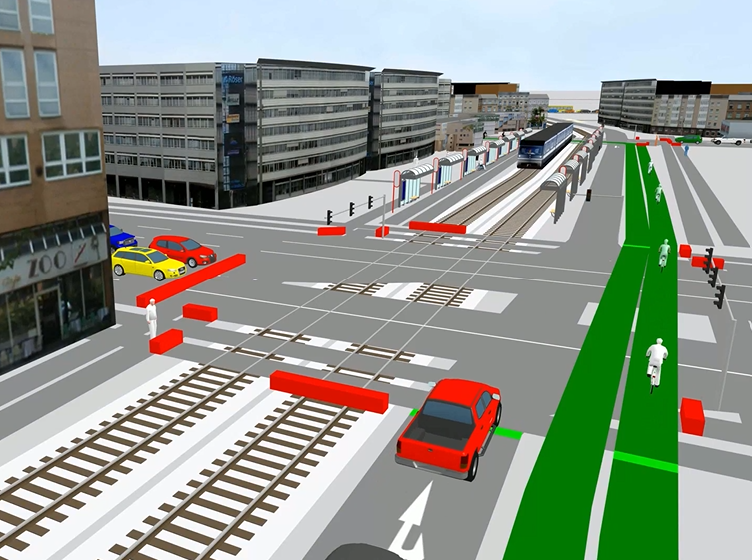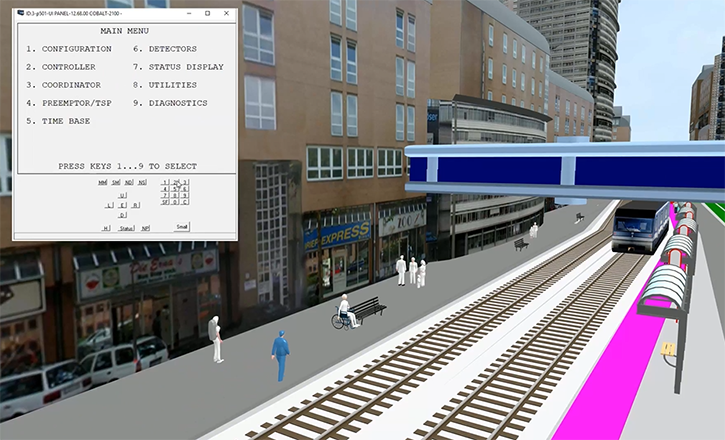TAC Sponsor Spotlight Article – Arcadis
By Mladen Pecanac, P.Eng. (Associate Principal – Practice Lead, Transportation Engineering, Arcadis), and Alaleh Adib (Senior Transportation Planner, Arcadis)
A new low-floor Light Rail Transit (LRT) system is being introduced in a dynamic city to reshape its urban transportation landscape and complement the existing transit network. This modern transit system is designed to improve mobility, foster sustainability, and enhance connectivity across the city. Unlike high-floor rail systems in use in Alberta, which required raised platforms for passenger access, this low-floor LRT operates without gates. The design supports seamless integration into the urban environment to create a more accessible, equitable and community-friendly transit experience.
At the forefront of this major initiative is Arcadis, a global leader in sustainable design, engineering, and technology-driven solutions. Arcadis has played a pivotal role in optimizing the functionality and efficiency of the LRT system, ensuring its integration into the existing transportation network while addressing the unique challenges of a low-floor, gate-free system.

Key Contributions to the LRT Project
Arcadis was engaged to provide traffic engineering services during the construction phase of expanding low-floor LRT system, with a focus on traffic signal operations. Our talented team developed the design and optimization of signal phasing and timing plans for 55 intersections, 48 of which included LRT crossings. A top priority was improving the safe movements of all modes of transportation—trains, pedestrians, cyclists, and vehicles.
To achieve these goals, the team implemented two levels of transit signal priority (TSP):
- Full Priority or Pre-emption: Full Priority overrides the normal traffic signal cycle to provide an immediate green light for approaching LRT vehicles. This provides minimal delays and allows trains to pass through intersections without stopping.
- Partial Priority or TSP: Partial Priority adjusts the signal cycle to favor LRT vehicles by extending green phases or shortening red phases. This approach balances the needs of trains with the flow of general traffic, optimizing operations for all modes.
These strategies were critical in addressing the unique challenges posed in an urban corridor. Promoting efficient LRT operations while maintaining safety for pedestrians, cyclists, and vehicles sharing the same space.
Unique Challenges of a Low-Floor, Gate-Free System
The low-floor gate-free LRT system presented unique challenges that required innovative traffic engineering solutions:
- Street-Level Integration: Unlike traditional systems, the low-floor LRT operates at street level, interacting directly with vehicles, pedestrians, and cyclists. This required a signal system that could manage these interactions while ensuring the safety of all users.
- No Physical Barriers: Without gates to separate trains from other modes at crossings, the signal system needed to provide clear and reliable control to prevent conflicts and provide safe operations.
- Pedestrian and Cyclist Safety: Due to the absence of gates, special attention was given to pedestrian and cyclist movements at crossings, ensuring that signal timing prioritized their safety and convenience.
Arcadis addressed these challenges by developing a state-of-the-art traffic signal system prioritizing the efficient movement of LRT vehicles while maintaining safety and minimizing disruptions for other users.
Measurable Results
Train Travel Time
One of the key performance indicators for the project was aiming to keep the end-to-end train travel time below 30 minutes. This goal was crucial for providing a reliable transit option that could compete with other transportation modes and attract riders.
To reduce train delays, Arcadis incorporated Full and Partial Priority routines into its traffic signal designs. This approach was particularly important in a gate-free system, where trains interact directly with other modes of transportation. By prioritizing LRT vehicles at key crossings, the system successfully achieved the operational goal of maintaining end-to-end travel times under half an hour.
Level of Service (LOS)
Another critical outcome of the project was maintaining an “acceptable Level of Service (LOS)” for various modes of transportation within the corridor. LOS is a measure used to evaluate the performance of transportation systems, ranging from free-flowing traffic (LOS A) to highly congested conditions (LOS F).
Through careful analysis and design, Arcadis prioritized that the signal system supported efficient LRT operations while minimizing disruptions to general traffic, pedestrians, and cyclists. Despite the complexities of a low-floor, gate-free system, the team’s innovative solutions maintained a satisfactory LOS for all users in the study area.
Improvements in Efficiency and Innovation
The success of the low-floor LRT system was made possible by several unique innovations and methodologies employed by Arcadis.
Seamless File Transfers Between Platforms
A significant innovation was the “effortless transfer of traffic signal controller databases” between the “PTV Vissim simulation platform” and the actual field-deployed traffic signal controllers. This capability prioritized that the signal settings tested in the simulation environment could be efficiently implemented in real-world operations, maintaining consistency between simulated scenarios and field conditions.
This streamlined process reduced the time and complexity of coding signal controllers, ensuring that configurations met the unique operational requirements of the low-floor LRT system.
Bench Testing for Signal Optimization
Arcadis also employed “bench testing” by transferring traffic signal controller databases between the simulation platform and the actual signal cabinets. This allowed the team to:
- Test and refine signal configurations in a controlled environment before field deployment.
- Align with train operation requirements, particularly for the gate-free system.
- Minimize on-site testing time and reduce potential discrepancies between simulation and field implementation.
These streamlined workflows enhanced the accuracy, reliability, and efficiency of the traffic signal system, supporting the unique needs of the low-floor LRT.
Advanced Traffic Simulation with PTV Vissim
To develop and test the signal phasing and timing plans, Arcadis utilized PTV Vissim, a state-of-the-art traffic simulation tool, integrated with the Econolite Module. This platform enabled the team to model and analyze interactions between LRT vehicles, general traffic, cyclists, and pedestrians in a microsimulation environment.
Key Benefits of PTV Vissim:
- Multimodal Simulation: Allowed for the simulation of interactions between LRT vehicles, vehicles, pedestrians, and cyclists, ensuring a comprehensive approach to traffic management.
- Transit Signal Priority Testing: Enabled the team to refine Full Priority and Partial Priority settings, ensuring efficient LRT operations while maintaining safety and flow for other modes.
- Scenario Testing: Allowed for the evaluation of various scenarios, including peak-hour congestion and special events, ensuring the system’s adaptability to real-world challenges.
- Integration with Field Deployment: Prioritized seamless transfer of signal controller databases from simulation to field deployment for consistency and error reduction.
These tools and methodologies allowed Arcadis to deliver a reliable and efficient traffic signal system tailored to the unique requirements of the new low-floor, gate-free LRT route.

Supporting the City’s Vision for Sustainable Transportation
The construction and ongoing expansion of this low-floor LRT system aligns with the city’s commitment to creating a more sustainable, connected, and livable urban environment. By providing a modern and efficient transit option, the project encourages residents to shift away from private vehicles, reducing congestion and greenhouse gas emissions.
Arcadis ’s innovative solutions have been instrumental in supporting these goals. By prioritizing transit operations while maintaining safety and efficiency for all users, the team has helped to achieve the vision to create a smarter, and more connected city.

